As I See It
by Mary Schamehorn
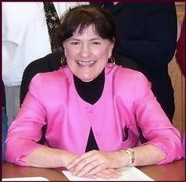
August 25, 2021
"The Bullards ferry pictured in the foreground of the accompanying Western World photo (first photo) is no more, and its replacement last Thursday by the beautiful new bridge in the background stirred many memories of residents who lived in this area when the first small ferry scow was propelled by hand-operated windlass across the Coquille river in September 1891 by the builder, Robert W. Bullard, pioneer, rancher, storekeeper and postmaster."
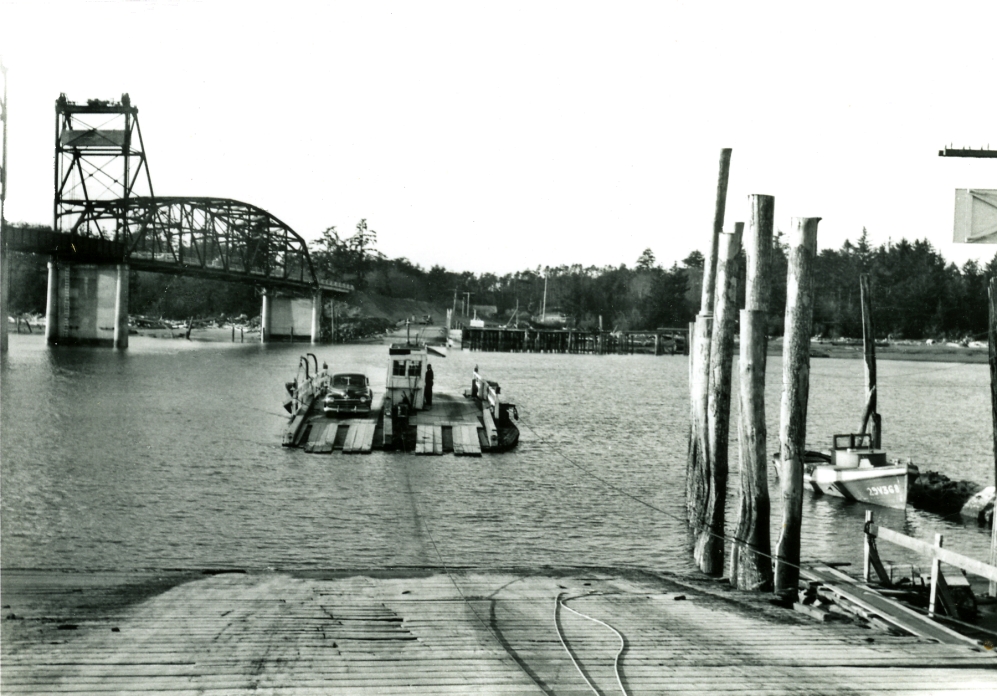 Last trip of Bullards Ferry, 1954
Last trip of Bullards Ferry, 1954
The headline in the April 8, 1954, paper said it all: "After 63 years of service, the Bullards Ferry bows out."
I had to look up the word "windlass," and determined it was a type of winch used especially on ships (or in this case the ferry) to hoist anchors and haul on mooring lines.
"When the first ferry crossing was effected, James Morrison was on hand to help Bullard set the passengers across, and on the final day the ferry was in operation last week, Morrison was one of the last passengers to be set across the river by Chief Operator F.S.Younce."
Several weeks ago in my column I had a picture of Mr. Morrison with the old American flag. He would have been 87 years old when he last rode the ferry with Bill Smith's grandfather, Mr. Younce.
"Bullard operated the ferry as a private enterprise until the county took it over in 1909. For many years Bullard supplied the scow and a gas powered boat for towing it, after the hand operation was eliminated, for the sum of $50 monthly.
"Operating expenses of the ferry at the time of its abandonment amounted to approximately $18,000 annually, and required two full time operators and a relief man. An average of 4,000 vehicles, including 1,000 trucks, crossed the ferry each month and between 13,000 and 14,000 passengers," according to the article.
The bridge which replaced it was financed jointly by federal, state and county funds.
The County's share was financed by a $300,000 bond issue, which was expected to be paid off in 20 years from savings realized by discontinuance of the ferry.
"Construction began in January 1953, and while still not fully completed, it was officially opened to traffic Thursday of last week.
"Further work completed this week included the placing of straw on the sides of the fills that make the approaches, for the purpose of helping prevent erosion, and the seeding of the ground."
While those living "on the other side of the river" finally had easy access, it is important to remember that Highway 101 to Coos Bay did not open until 1960.
I found an article from the September 4, 1952, Western World, with a better understanding of what was carried on the ferry, including for the month of July 1952: 12,141 passengers, 3,331 vehicles, 4,549 trucks, 176 1/4 tons of cargo and 68,310 gallons of milk.
I remember making several trips across the ferry with my grandmother, Grace Felsheim, at the wheel ... and me mostly worrying if we would make it. We always did ... even the one time that we were stuck in the middle of the river after a problem caused the ferry to temporarily stop working in midstream.
I hear a lot of concerns about the bridge today, which many say is not safe for pedestrians and bicyclists, but considering the alternative .... I'll take the bridge any day.
The second photo, taken in the 1930s, shows the ferry long before the bridge was built.
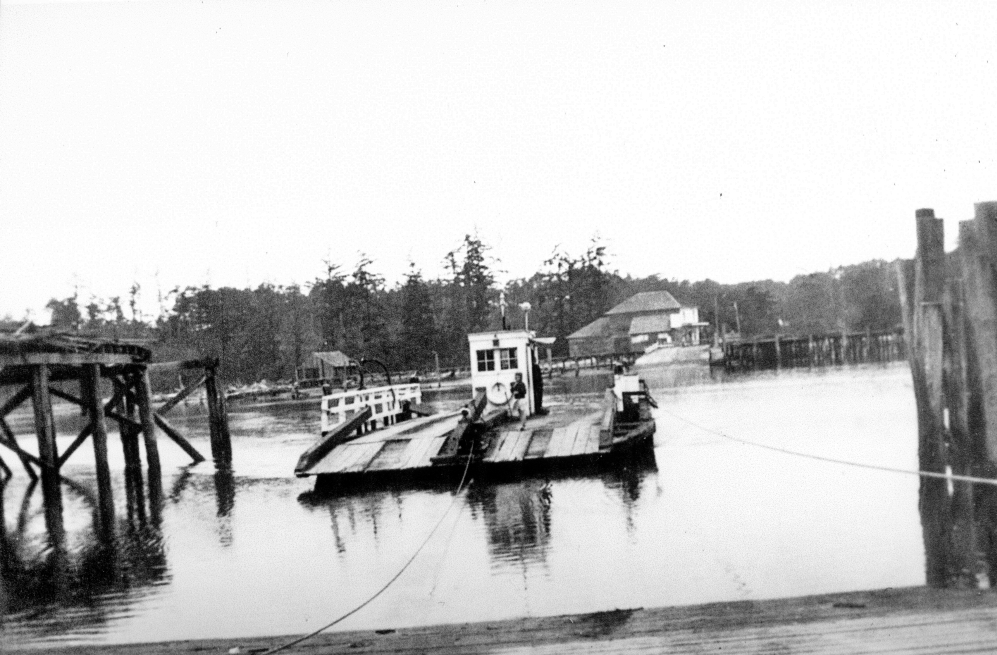 Bullards Ferry, 1930s
Bullards Ferry, 1930s
Across the river you can see the Bullards Store, which was later moved to another location because the property on which it stood had to be torn down to make room for an approach to the new bridge.
For years the building housed the Bullards post office, which was established in June 1897 when Robert W. Bullard, pioneer resident and founder of the Bullards ferry, was authorized to open a post office and to call it by his own name, with the addition of the letter "s".
Bullard and his son-in-law Lester Bundy, were the only two men to serve as postmasters. The Bullards Post Office closed on Jan. 31, 1955.
In the early days, before the ferry, mail was brought to Bullards by boat, two of the most active being the Charm and the Dispatch.
The third picture was taken in July of 1975 when the Bandon Rural Fire Department had just received equipment valued at $1200, which included two air masks and a portable resuscitator, through an agricultural marketing promotion program sponsored by Dow Chemical USA.
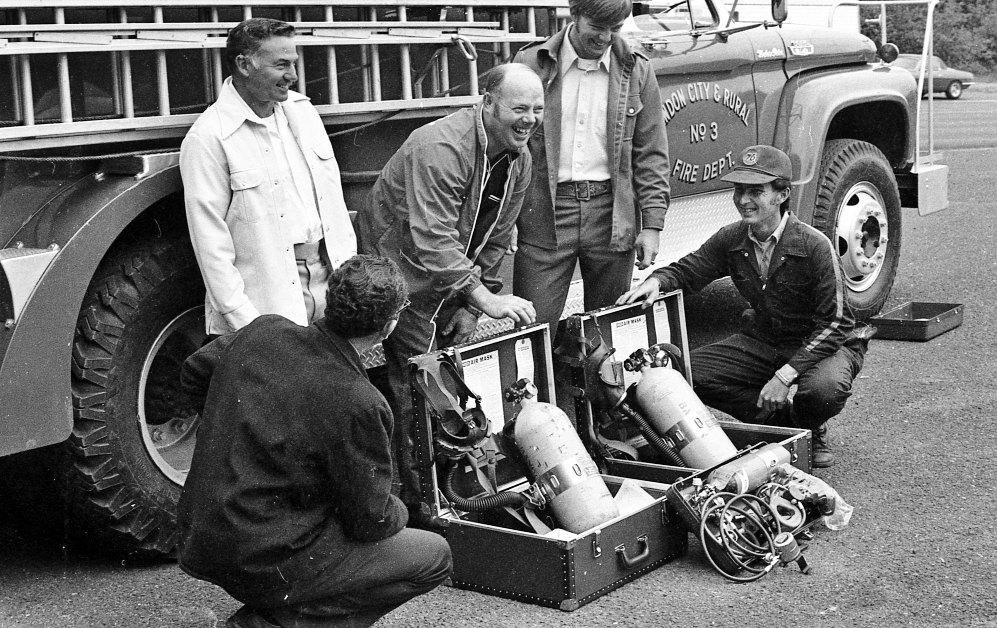 Bandon Rural Fire Department receives equipment, 1975
Bandon Rural Fire Department receives equipment, 1975
Pictured, from left, were City Manager Bill Donahue, Rural Fire District board members Bill Pullen, Jack McMahon and Barry Winters, and Fire Chief Lanny Boston. Winters still lives in Bandon and Boston remains the fire chief.
* * *
I was so sorry to learn this week that long-time Bandon resident Mike Lane had died after battling cancer. Mike's wife, Martha, taught in the Bandon schools for some years, and they have a son Mark and a daughter Mary, who is married to Craig Minkler. Mary and Craig have a young son, Emmett.
I got to know Mike when he attended several of our city council meetings as we verbally battled the issue of whether or not we would support a Marine Reserve offshore from the Coquille River. I felt it was pretty much a political issue, and when it ended in a 3-3 tie, I knew I was right.
Mike, as a commercial fisherman who represented the fishing industry on a number of important commissions, would have to carry out the wishes of the council, who were completely divided on the issue. But when it came down to a tie, the decision was completely up to me. And for the first and only time in my 17-year career, I refused to vote. One of my "liberal" friends on the council was furious and he commanded me to vote. But I refused.
So the issue was moot, and it left Mike with the freedom to vote his conscious as to what he felt would be best for those he represented, as well as for the environment. And I had no doubt that he would do the right thing.
A few days later, I saw him in the store, and he thanked me for having the courage to not take a position on an issue, which we clearly were not ready to make nor did we understand the ramifications.
Truly one of the "good guys," Mike is just one more in a long line of our friends and neighbors that we have lost in the last couple of months, and he will be missed.
* * *
I received a call the other night from one of my doctor friends, who is passionate and extremely worried about the huge surge in Covid cases that Bandon and Coos County have experienced of late. He is worried that people do not seem to be taking it seriously, in spite of the fact that I know of four people from Bandon, or related to someone in Bandon, who have died of Covid in the last two weeks.
I have learned that there were 17 cases of breakthrough Covid at Pacific View this weekend, and I already knew there were a number of cases in the memory care unit.
I understand one of our local doctors, Doug Crane, has been caring for 30 people who tested positive, but who did not have a primary care doctor.
By far the largest percentage of people who end up in the hospital, and on a ventilator, are those who have not been vaccinated.
Nurses are interviewed nightly, urging people to get vaccinated. One from Peace Health said, "It is heartbreaking ... and preventable. Of the 14 patients in the ICU, only one was vaccinated. And we're angry." The latest surge, which in places like Bandon is far worse than at any time in the pandemic, is taxing health care professionals and the hospitals they serve.
One doctor said today that people are so desperate for a treatment that they are trying experimental drugs that have been used on animals ... while at the same time they are unwilling to take a vaccine that will pretty much keep them out of the hospital, and has gone into the arms of 170 million people in the US.
Heartbreaking and mind boggling is the best way to describe what is happening. Even former president Donald Trump was on TV today urging people to get vaccinated.
Governor Brown has issued a mandate that requires all teachers and health care workers to be vaccinated by a date certain. Many are hesitant because they say the vaccine has not received FDA approval, but that is expected to come in the next week, at least as far as the Pfizer vaccine is concerned.
Please, I urge everyone to get vaccinated, and to wear a mask anytime you are indoors around other people. If not for yourself, do it for your friends, your family and our community!
* * *
I received word last week that David Johnson (Bandon High School Class of 1976) and a resident of Bandon for the past several years, had died of Covid.
According to my source, he was very ill, and from Bandon, he was sent to Bay Area Hospital. Then they wanted him to go to Roseburg, but the ICU in Roseburg was full. And he died.
I remember David well as he was in the same class with my youngest sister, Mindy.
* * *
I recently received the latest rainfall (if you can call it that) data from Gerry Terp, who recorded nine-tenths of an inch of rain for July, compared to fourth-tenths of an inch last year and a third of an inch in 2019. July is historically one of the driest months of the year, and this year was no exception.
Every day I pray for rain ....
As I See It
by Mary Schamehorn

August 18, 2021
Through the years I have often mentioned Millard School, but without a lot of information about what a first-rate unique school it really was. There are lots of stories about Generals and other top ranked military officials who "got their start" at Millard School.
Millard School was established on Langlois Hill (first photo) in the spring of 1953.
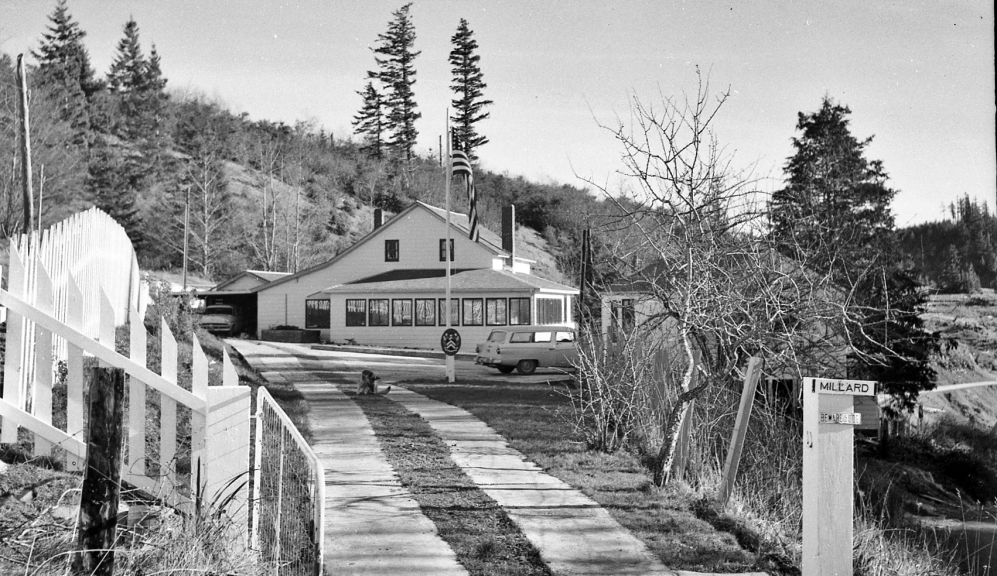 Millard School
Millard School
An article on the front page of the April 23, 1953, Western World reads: "the chance to combine a summer ranch vacation with a year's high school work in Math and English is what the Millard School of Langlois is offering to high school boys of average intelligence or better."
What would amount to a year's worth of math and English would be condensed into the nine-week course, which opened June 15 and closed Aug. 13.
"The Millard School is owned and operated by Colonel Homer B. Millard, owner and operator of the famous Millard school for West Point in Washington, D.C. As a result of his 21 years of successful operation of his West Point school, Colonel Millard is equally expert in college preparation and the handling of young men.
"Many parents feel that a boy who has had at least a year in college prior to his induction into the armed forces is more likely to go ahead with his college upon reverting to civilian status than the boy who has had no college experience.
"No country in the world is as wasteful of its young people's time as our country.
"As a private boarding school, with 24-hour-a-day control of its students, it is able to provide thorough instruction and, through close supervision, the development of good study habits.
"The emphasis on discipline and supervision will be of particular interest to parents, concerned about their children's whereabouts during summer vacation days and nights."
I can tell you from talking to Millard boys when I was in high school, back in the '50s, that discipline was a very big thing at the school, and no one wanted to sneak out at night because of the German Shepherds, who were part of the Millard "family."
The article explains that during World War II, Colonel Millard served as Deputy Chief of Staff for the 9th Bomber Command at Las Vegas, N.Mex., and set up and commanded the Combat Crew Schools at Salt Lake City. He was a native Oregonian and attended Lincoln High School in Portland.
"Mrs. Millard also combines a military, administrative and teaching background." It explains that after teaching for several years at the University level, Mrs. Millard entered the United States Navy as a WAVE, serving for almost nine years before her resignation. At that time Mrs. Millard was a teacher at Bandon High School.
Mrs. Millard was my English/grammar teacher at BHS, and I can honestly say that I learned more from her than I did all my other teachers put together, but maybe it was because it was my favorite subject. Math, on the other hand, was a different story.
In early 1962, the Millards closed their school in Langlois after purchasing the former Tanglewood Resort property south of Bandon and moved the school to its new location. Several months later Col. Millard died of a massive heart attack.
I took the second photo in November of 1962 of Colonel Kenneth E. Tiffany, who had been hired as the principal of the school, to assist Mrs. Millard who had taken charge after the death of her husband.
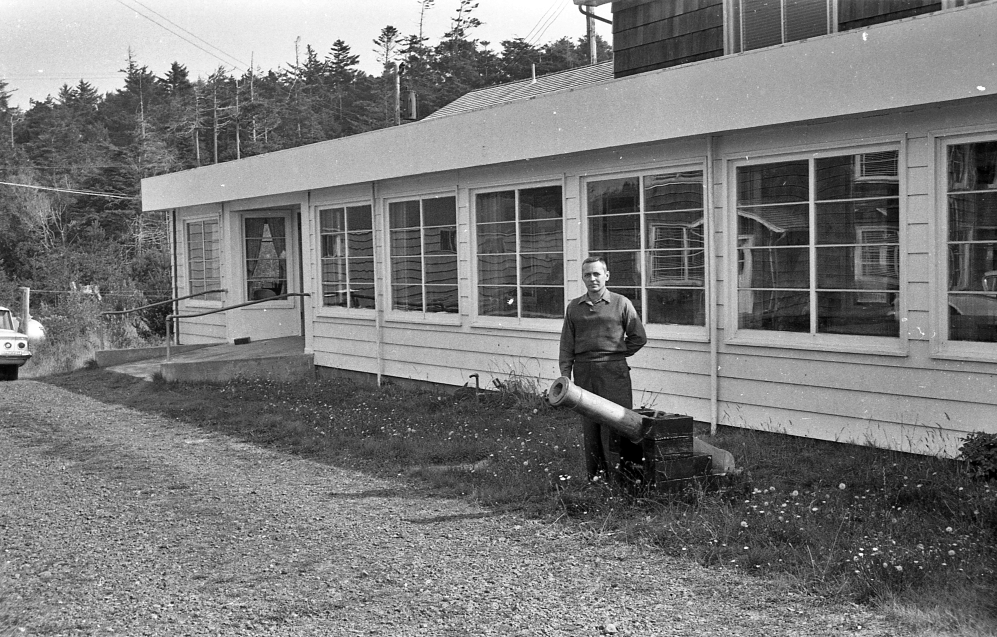 Colonel Kenneth E. Tiffany, prinicipal, 1962
Colonel Kenneth E. Tiffany, prinicipal, 1962
The cannon that Col. Tiffany stands alongside was later given to the Bandon Historical Society museum by Mrs. Millard. In 1962, Paul Tiffany, 21, was a student assistant to his father.
In an article about the school moving to Tanglewood, which I wrote, it explains that on Saturday evenings, the boys who had not broken rules during the week were brought into Bandon to attend the local theater, or on special occasions a teenage dance.
"The boys no longer sleep in barracks as they did when the school was on Langlois Hill, but now sleep two or three to a room (in the building which formerly housed Tanglewood Manor.) The large apartment house is used by Mrs. Millard as her home, and the bottom floor is the administrative office.
The former skating rink has been turned into a gymnasium for the boys, and the west end of the building is used as a kitchen and dining room." After the Millards purchased the property, two new classrooms were built east of the gym building.
Last week, Jim Proehl, Gayle Nix, Donna Mason and I were given a tour of Tanglewood by Dunes staff housing manager Katy (Vierck) Gonzales, and it was like stepping back in time when we entered the big skating rink. It frankly looked just like it did decades ago when we used to go skating out there. As I mentioned recently in my column, the property has been purchased by Bandon Dunes Golf Resort to be used as staff housing.
The third picture I am sharing is of long-time city attorney and close friend Myron Spady, who died Thursday, Aug. 12, at the age of 97.
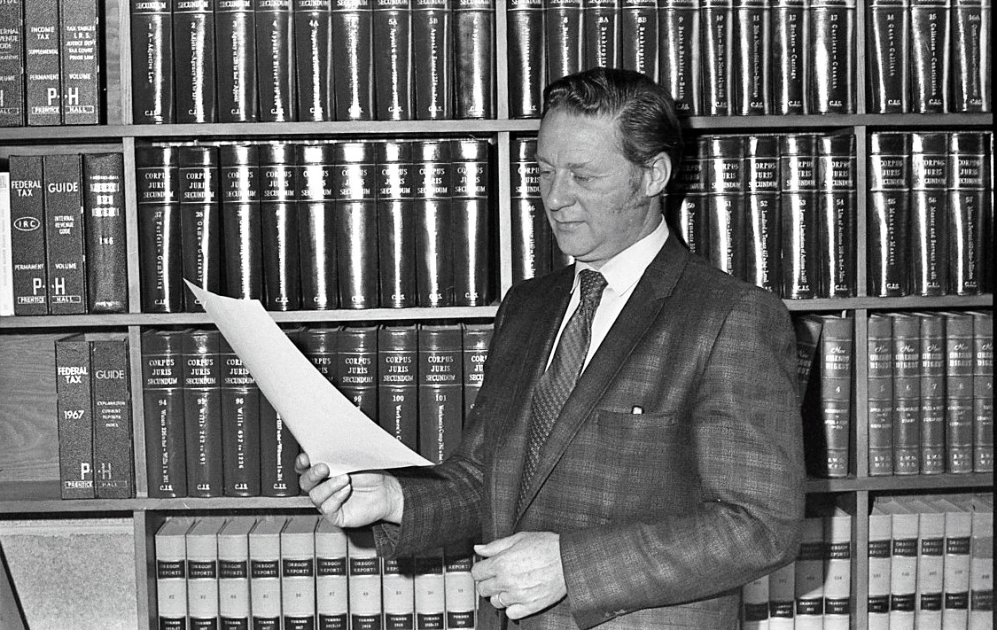 Myron Spady
Myron Spady
I chose to share this photo because it is the Myron that we knew and loved for so many years, although I did share a good one of him, taken just a few years ago, on Facebook.
He was a charter member and past president of the Bandon Lions Club, which was chartered in 1951 with 18 members. In 1952, he was named City Attorney, a position in which he served for nearly 40 years before Fred Carleton took over.
Myron was very active in the community and was always willing to lend a hand, which I have learned by going through old issues of Western World and often seeing his name as being part of clubs and organizations which served the community.
For years he and Tom Gant were in charge of cooking the meat in the open fire pit at City Park for the Cranberry Festival beef barbecue.
He was totally devoted to his wife Lillie, who died some years ago, as did his son, Tim, and daughter, Susan.
Among his immediate survivors are three sons, Mike, Mark and Marshall, and their families.
I still remember the wonderful parties Myron and Lillie would host when I was on the city council, back in the late '70s. Their home was beautiful and so welcoming.
It is sad to think that in a four-month span, we have lost the two city attorneys who served the City of Bandon for nearly 70 years. I am sure that is a record that will never be broken.
* * *
I saw on Facebook in the Bandon Chamber of Commerce Member Forum that the owners of Bandon Auto Repair (located on Grand Avenue near Face Rock Creamery), James and Ashley Richmond, had lost their Gold Beach home to fire. They have commuted from Gold Beach since buying the business nearly three years ago, although their three young children attend school here.
A Go Fund Me page has been set up to assist the family.
* * *
I was also sorry to learn that John Drew, husband of former city councilor Nancy Drew, died last week at the age of 90. Through the years that Nancy served on the council, John always accompanied her to meetings and to the league conference, so I got to know him well. He was a neat guy and a great ambassador for Bandon.
* * *
I always love it when people share their good fortune or positive stories with me, and this week I heard about Shane Wilder, the grandson of Donna and Richard Misseres of Bandon, who was a member of the six-person Southwestern Oregon Community College Culinary Team that recently won a national award at a competition held in Orlando, Fla.
Wilder, who is originally from Eugene, now works at Bandon Dunes Golf Resort.
Their prize winning meal was a salmon dish with a crab reduction sauce, a summer salad with tomatoes and red wine vinaigrette, a coffee roasted lamb, and a bourbon poached peach dessert.
* * *
Covid continues to rear its ugly head, with more of our local businesses closing for several weeks, or long enough to have their employees tested. The latest announcement of a lengthy closure, to Aug. 28, is Billy Smoothboars, after Dan Barnett posted that illness was forcing the closure. Also Sunday, Lord Bennett's posted that it would not be open that night because of a possible exposure to a staff member.
Others, like Tony's Crab Shack, have now reopened and were greeted with standing-room only lines waiting to be served.
I went on the Facebook page of the City's front-desk gal Linda Eickhoff, and there were many friends expressing sorrow for the loss of her father, who died of Covid, while the family was on a family trip to Nebraska last week. It is so sad because Linda and her parents were very close.
I know I sound like a broken record, but if you not been vaccinated, please do so as your chances of ending up in the hospital are diminished, and you won't be as likely to spread it to your friends and family.
* * *
After reading my story about Bandon's efforts at eradicating gorse back in the 1950s, Liza Ehle wanted me to be sure and share with my readers what is being done about gorse now through the efforts of the Gorse Action Group. "We are proud of what we have accomplished in Bandon, and statewide, with the cooperation and collaboration of our 35 hardworking partners. Our efforts with gorse represents an amazing volunteer commitment, many hours of strategizing and program development, new science and management tools, even bio-control research and experimental machinery. Our ongoing success is highlighted by the new (city) ordinances and county Urban Growth Boundary connectivity, state and federal grants and programs now firmly in place, and our parks and highways making it a priority with multi-year strategies.
"Additionally local landowners have been jumping on board, removing hundreds of acres this year as we coordinate with them. Finally, here in Bandon, at Ground Zero, we have begun the seven phased District Abatement plan which is well underway with coordination by our Vegetation Manager Gerald "Bear" Slothower, the city utility crews and contractors, and a code enforcement officer. I think we have a lot to be proud of in our future for gorse control," said Ehle of Windward Gardens, LLC.
As I See It
by Mary Schamehorn

August 11, 2021
Although the first picture I am sharing this week, of a man spraying chemicals on gorse in town, was taken a few years later, there was a lot of activity in 1950 concerning the eradication of gorse.
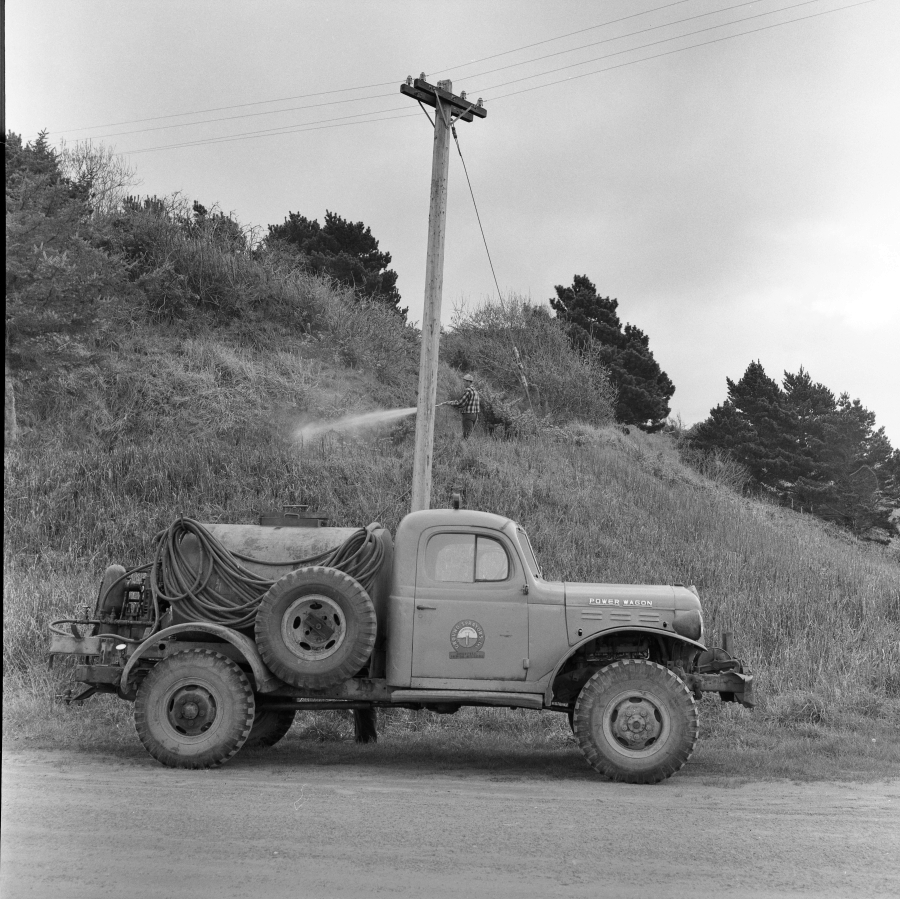 Spraying gorse, 1958
Spraying gorse, 1958
For many who had lived through the Fire, only 14 years earlier, they could not forget the horror of losing their homes and they were ready to do what it would take to get rid of the gorse.
In May of 1950, the voters passed a five-mill, five-year property tax levy with its number one goal to address the gorse problem. Part of the money was also to go to improved street lighting and a replacement fund for a new fire truck.
Emboldened by support of the voters, the city was ready to start on its gorse control program "as soon as owners of gorse-infested property indicate their willingness to allow the city to go on the property for that purpose," said an article in the Western World.
The first step, which was to bulldoze fire trails where needed, was to be started as soon as property owners granted the necessary easement, which would allow the city access to the property for a period of five years for the sole purpose of destroying gorse by burning, cutting or chemical treatment. The easements were not recorded and were not assignable, so they would not interfere with sale of the property.
The recommended plan was to burn the gorse first, wherever possible, both as a first step in the treatment, and to reduce the existing fire hazard. After burning, and when the gorse was from two to six inches high, the area was to be sprayed with a mixture of chemicals at the rate of four pounds per acre.
Several weeks later, on the Fourth of July, firemen battled flaming gorse for two hours on the bluff overlooking the beach (second photo) after fire broke out during the aerial fireworks display.
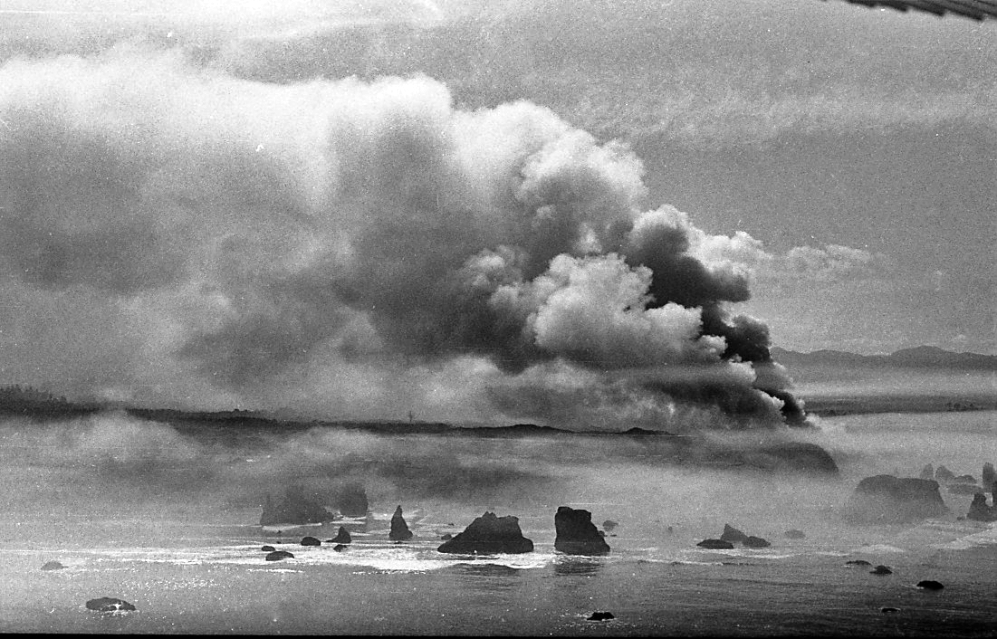 Flaming gorse caused by fireworks
Flaming gorse caused by fireworks
The fire started shortly after 9 p.m. with the chamber of commerce fireworks display underway about a half mile north on Coquille Point. The fire came so close to the G. R. McNair home that the McNairs had moved many household items from the smoke-filled house before the fire was controlled.
Still determined to address the problem, the City declared Sept. 24, 1950, as "Gorse-Killing Day" and urged all able bodied men to meet in city park, armed with axe, brush hook or hand saw. They would be split off into groups, each of which would attack one small section of growing gorse somewhere in town. The mayor and the councilmen had donated their month's pay to furnish coffee and cream for the community picnic, with the women of the community to provide the food.
Unfortunately it rained the day, and Gorse-Killing Day was not held.
It is clear from the amount of gorse that still exists in the community, efforts through the years to eradicate it have not worked.
The third picture I am sharing was taken in May of 1958 as Hazel Colgrove, president of the Bandon Women's Civic Club, presents Lloyd's owner Mel Dahl with a plaque for his long-time support of the club, which held their meetings at Lloyd's.
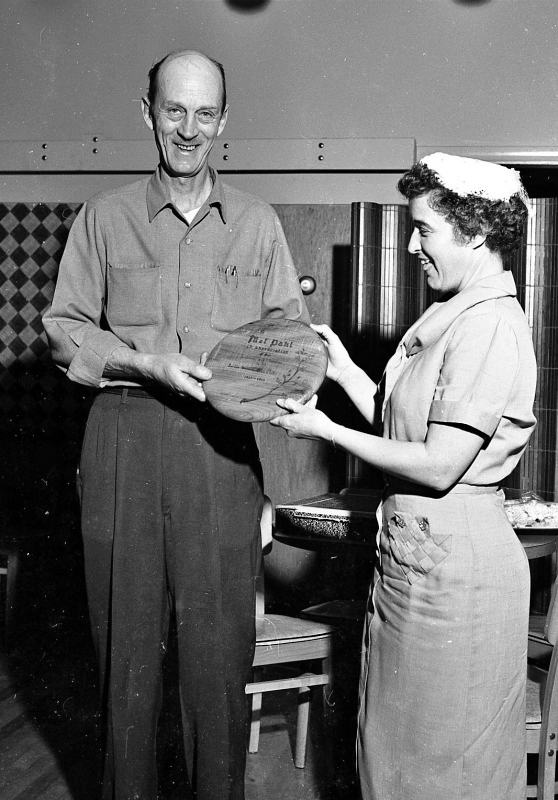 Hazel Colgrove & Lloyd's owner Mel Dahl, 1958
Hazel Colgrove & Lloyd's owner Mel Dahl, 1958
* * *
Recently, one of my siblings found several boxes of mostly family pictures, and it was suggested that I might want to look through them before we determined what to throw away and what to keep. I was pretty sure I had already looked through all the family photos, so I begrudgingly spent some time dutifully going through the boxes. Boy was I wrong.
You can imagine the thrill when I found an envelope of 21 2"x3" photos taken within days of the Bandon Fire of September 1936 by my grandmother, Grace Felsheim. And, best of all, she noted on the back of each photo what had been there before the Fire.
There was even one of my 20-year-old mother standing next to the ruins of the family home, labeled "Martine (short for Martha Virginia) next to her 'home.' " All that remained was a large stone fireplace and the chimney. Mother had left the previous weekend for her sophomore year of college, riding back to Eugene with her neighbor Raymond McNair. An accomplished pianist, she had left her prized sheet music collection in a box on the glassed-in porch at their 11th Street home, planning to return the following week to take them to the University with her. So while she did save her clothes and other things she had taken to college, her prized sheet music collection was gone. But then considering that my grandparents were spending the weekend of the Fire in Florence on a short vacation, and it took three days to get back to Bandon because of the burned out bridges, sheet music is only a very small part of what both sides of my family lost in the Fire. They virtually saved nothing except what was in the Western World office, which, while damaged, remained intact.
To say that these photos are priceless is an understatement. They are some of the best I have ever seen of what remained after the Fire.
I scanned them into my computer and then gave them to Jim Proehl at the museum, who scanned them at a much higher resolution so they could be further preserved.
I have always wondered if locals, or even people who used to live here, had pictures of the Fire that we had never seen. But I certainly did not expect to find them among my family's possessions. I am guessing that after my grandmother died in 1973, my mother inherited her treasures, but instead of going through them, they were apparently put away for safekeeping. Mother died in 2013 at the age of 96, so we are finally going through boxes that had been in storage and out of sight for nearly 50 years.
I will be sharing some of the best ones in recent weeks.
When I think of the money I have spent in the past few years purchasing old postcards of Bandon and newspaper photos of the Fire (some for more than $25 apiece), I can only imagine what I would have paid for a treasure trove like this had I found them on the Internet.
* * *
I recently saw a study done by United Van Lines, which determines which states people are moving to ... and which states they are leaving.
I think I've figured out why the rental market is so hot; it seems that Oregon is the No. 2 destination of people fleeing other states, and the only state with a larger influx of people is Idaho. Our neighbor to the north, Washington, is fifth, while our neighbor to the south, California, is the No. 1 state that people are leaving followed by Iowa, Virginia, Mississippi, New Jersey, Illinois and New York.
Places with great weather, like Florida (No. 7) and Arizona (No. 3), are also considered desirable places to live.
Housing prices definitely vary in different states. For example the median price of a home in Boise, Ida., is $332,698; in San Francisco, the median price is $1.32 million. The median price of a home in Oregon was said to be $344,200.
I really thought that with the mess in Portland that more people would be leaving Oregon; but wow, was I wrong. It seems that Oregon's plentiful trees and lush vegetation are big draws as is the fact that "Oregon is rife with tech industry jobs," particularly in the Portland-Hillsboro area, which is referred to as the "Silicon Forest." I've heard Portland called a lot of things lately, but no sense going there ....
* * *
Learning recently that 19 percent of the Covid cases in Oregon are breakthrough cases, meaning that vaccinated people are testing positive, has made me a bit uneasy about a post that I read this week concerning three employees who had tested positive at the Bandon VFW Post. The Commander was urging anyone who had been at the Post on the previous weekend should be tested. A lot of us were out there for the memorial service for Ken Butler, and we were in pretty close quarters for at least an hour and for some much longer than that.
So far I haven't heard if any of the guests have tested positive, but I do know that there was a big surge in the number of people who came to Southern Coos Hospital last week wanting to be tested.
I also hope this will result in an increase of those getting vaccinated. I did read that 95 percent of those hospitalized with Covid in Oregon are people who have not been vaccinated.
Amy Moss Strong in the Bandon Buzz Saturday had a list of businesses which have closed or reduced their hours due to Covid exposure and staffing shortages. As of Aug. 7 they included Tony's Crab Shack, The Loft, Subway, Tin Cup Coffee, Rancho Viejo, The Human Bean, Herbal Choices and the VFW Hall.
* * *
The Old Town parking situation was made even more critical this week when Lisa Schilling, who owns the lot between First and Highway 101 adjacent to Fillmore Avenue, closed it. Earlier, Fred Gernandt, who owns the large gravel parking lot on First Street, across from the Port's marketplace building, fenced it off.
The parking situation became even more dire Saturday when a large wedding was held on Jetty Road, with cars parked all along the road and partially up Edison Avenue (better known to locals as Coast Guard Hill).
A woman who lives on Beach Loop Road told me Sunday how awful the parking situation has become during the Circles in the Sand events, which are sometimes held two or three times in a week. She said she is looking at moving from the community, and told me that her neighbor is on tranquilizers because she is so upset over the illegal parking along Beach Loop.
And the city is getting ready to put "no parking" signs along one side of Face Rock Drive because it is so dangerous on "Circles" days that neighbors say an emergency vehicle could not get through the cars parked on both sides of the street.
Believe me we hear the concerns, but there is no easy solution. Beach Loop definitely needs to be posted "no parking," and then it would need to be enforced.
I guess it's safe to say "Bandon has been found," now we just need to figure out where all our visitors can park... and not in someone's front yard.
* * *
Lately I've been seeing a lot of familiar faces, but not under the happiest of circumstances as most have been at memorial services, with the latest on Sunday for long-time resident Jim Reilly.
The Reillys backyard was the setting for friends and family to gather in memory of Jim, with Donna and her children and grandchildren on hand to make people feel welcome.
We've all lost way too many friends this summer....
As I See It
by Mary Schamehorn

August 4, 2021
While reading through the 1951 issues of Western World I spotted a story headlined "Story of City Built on Floras Lake Shore in Curry History." Fascinated, I read on, but didn't stop there. I also went to Peterson and Powers' "A Century of Coos and Curry" for more of the story.
A short story written for the paper by Dale Brown, a member of the senior class, talked about the town.
"In 1908, on the shores of Floras Lake began the construction of 'Pacific City.' The city was promoted on the supposition that a canal could be built (first photo) between the lake and the Pacific ocean, providing a deep water harbor.
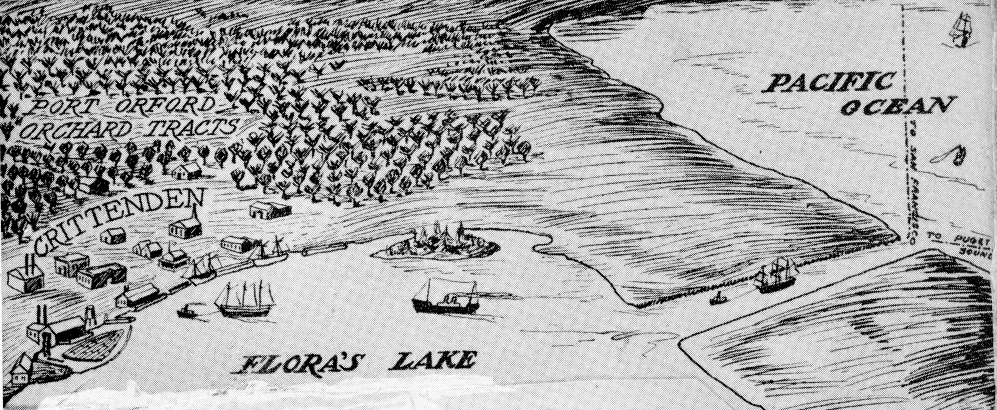 Proposed canal at Floras Lake
Proposed canal at Floras Lake
"While carpenters worked day and night, long lines of teams hauled lumber from Bandon and Port Orford. Land was cleared, sidewalks laid, wharves built and many other buildings were erected.
"Lots, totaling six thousand in number, were sold, from $12.50 to $300 apiece. A newspaper, the Floras Lake Banner, was established, publicizing the place, bringing in people from all quarters of the country. After the excitement had settled, citizens began to wonder where the industries were to spring from. What was to be shipped out of the port? Would there be enough raw materials to make a shipload of freight?
"Although the War Department had given permission to dig a canal, the final blow came when it was discovered that the lake was about 40 feet above sea level (and would have been quickly drained into the ocean).
"Merchants closed their stores and professional men their offices. People who could, left.
"Now only the brush-grown walks, the rotting wharves, and the crumbling foundation of the three-story hotel remain of once the largest town in Curry County."
In the Peterson and Powers book, the town is referred to as Lakeport, and in 1915 two hikers found the three-story building, still upright on its foundations ... the Lakeport Hotel. They were allowed to stay one night for free. The next morning they learned that the grizzled old hotel host was the only remaining resident of Lakeport. "The day before there had been three. Two had quarreled and one had killed the other." The killer was on the lam.
The second picture is of Lee Roberts, who occupied the old hospital on First Street for several years, dating back to 1979.
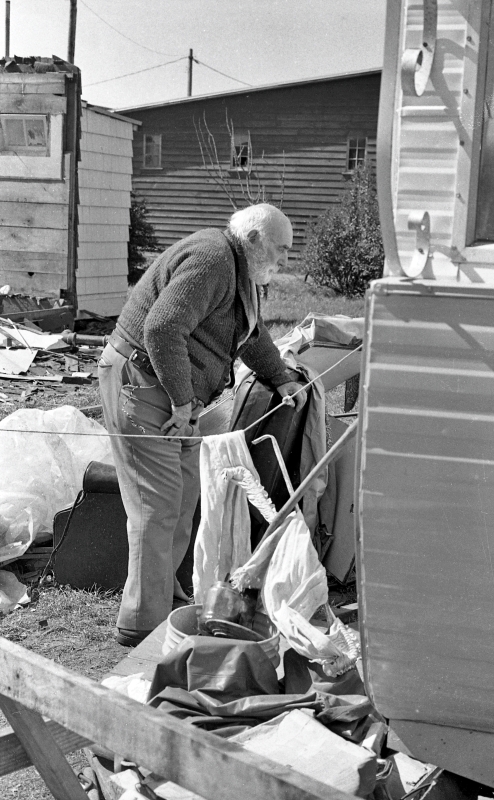 Lee Roberts
Lee Roberts
The property was such a mess that the city council (of which I was a member) declared it a nuisance and gave him 90 days to correct the problem. Because of the old hospital's close proximity to the Bandon Theater, and the fact that it had already been the scene of several fires, the council felt it was time to clean up the area, which they considered both a fire and a health hazard.
The third picture I am sharing was taken in June of 1957 during the Explorer Post 17 dinner and awards program.
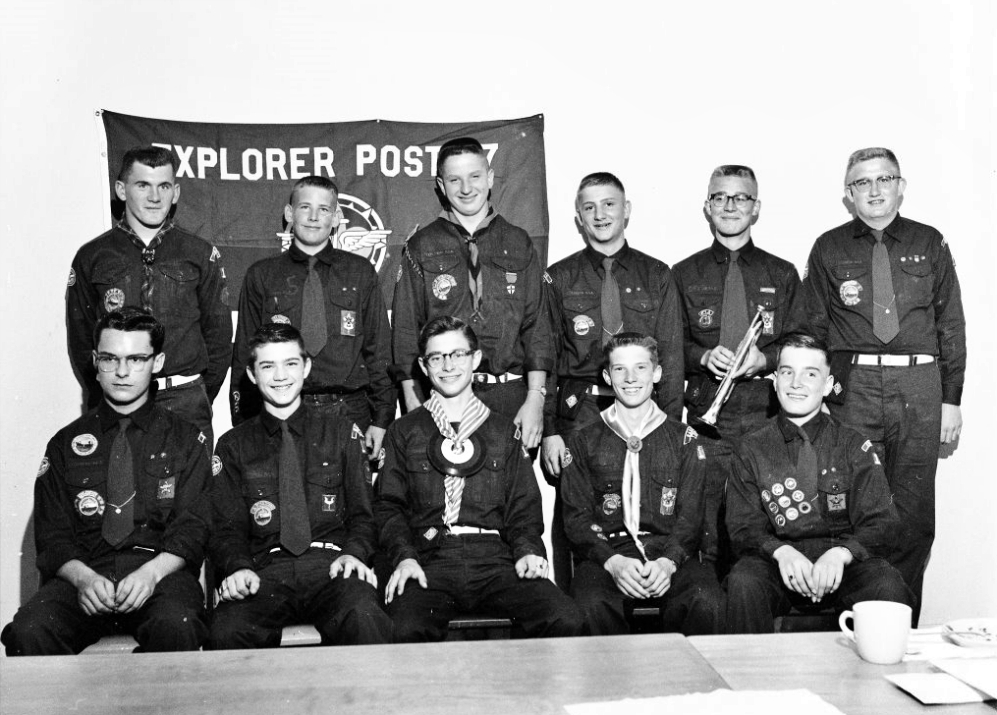 Explorer Post 17, 1957
Explorer Post 17, 1957
Unfortunately I could not find the story in the paper, so I am guessing at the names of those in the photo. I think I did pretty well, but I am sure people will correct me if my memory failed me.
In the back row, from left, I see Chuck Ward, Ron Rose, Larry Gerber, Jim Knox, probably Mike Anthony and Ron Knox. In front are Jeff Valentine, probably Ron Clendenen, Dayton Turner, George Sweet and Larry Baker. I know Dayton is a regular reader of my column and believe me, if I have erred, he will let me know.
* * *
If you'd like to learn more about our history, you are invited to join the Bandon History Hike this Sunday, Aug. 8. There will be two options: people can join archaeologist and historian Reg Pullen and me for a four-mile walking tour of Bandon, or join Historical Society volunteer Jim Proehl for a faster paced version, which will head up Fillmore Avenue and toward the schools before heading to the beach. Actually I will be talking about various buildings in Old Town, but will leave the hike at the marketplace, and those hardier than I can continue on west and down the beach with Reg. Interested people can meet at the museum at 10 a.m.
I plan to bring some photos of various buildings, and what they may have looked like in the '50s, '60s and '70s, or even before the Fire of 1936.
* * *
In the past couple of weeks I've been sharing Reg Pullen's story about the salmon crisis on the Coquille River. As pointed out earlier, the Coquille River is completely closed to all salmon fishing in 2021.
Up until 2018, the 70 pairs of wild spawners needed to reach target smolt goals were being netted from the river near Myrtle Point, but only 20 were netted in 2018. Since then no wild fish have been used to augment hatchery production nor are any planned this year, said Pullen.
"The ODFW held out hope that increasing smolt releases at Ferry Creek would result in enough returning spawners to support the hatchery program, but that has not happened.
"The initial thought was that returning hatchery Chinook would swim up Ferry Creek to the hatchery, where they could be spawned. Due to a severe drought and ever later fall freshets that would allow salmon to navigate the brush- and beaver-dam-chocked creek, no salmon have returned to the hatchery. In 2020 a trap was installed just upstream from the Face Rock Creamery, but only seven fish were captured. Seal predation at the mouth of the creek may account for the poor returns, but it appears likely that the entire hatchery program is doomed to failure unless drastic measures are taken," he added.
"The ODFW seems unlikely to change their position, given the Wild Fish Policy that discourages hatchery production. However, efforts are underway to change that. The Coquille Indian Tribe views the salmon as a cultural icon, and intends to lobby for increased hatchery production, as many tribes have done along the Columbia River. The 60,000 member Oregon Anglers Association is demanding that something be done to prevent the complete loss of the Coquille River as a salmon fishery. Some are advocating for the creation of a Salmon/Trout Enhancement Program (STEP) on the Coquille River much like the one at Coos Bay that turned a salmon run of around 800 fish annually to a run that now often exceeds 20,000 fish.
"One can only hope and pray that the needed spawners to perpetuate the hatchery program by some miracle appear this fall. Perhaps more drastic measures are called for, like asking the Legislature to apply pressure on the ODFW to allow for the netting of 70 pairs of wild fish to rebuild the Ferry Creek hatchery program. You can help by writing or calling your legislators, including Boomer Wright and David Brock Smith, joining the Oregon Anglers Association, and asking the State of Oregon why riparian and water quality regulations are not being followed," said Pullen.
One needs only look through years of old Western World newspapers to see what an important role the salmon fishery has played over the years not only from a commercial standpoint in the early days, but the huge economic impact from the recreational fishery.
* * *
Wow. I was shocked to read on Facebook Sunday that the most popular spot on First Street, Tony's Crab Shack, would be shut down until Aug. 13 because of a "team member's exposure to Covid." The post said, "we are taking the safety precaution of closing from today until Aug. 13. We apologize for the inconvenience. See you soon."
And that's not the only thing that happened in Old Town. Last week, Fred Gernandt, who owns the big gravel lot across from the Port's marketplace building, fenced off the property from public use. The port and the city are working together in the hopes of negotiating a lease of some sort because of the big demand for parking in Old Town.
* * *
Bandon native and long-time resident of Gold Beach Bo Shindler has just authored a book, titled "With Barely Two Nickels To Rub Together."
"This true story documents the extraordinary life of an 'every man' who rose from humble beginnings to realize substantial accomplishments in spite of harrowing experiences and difficult circumstances," said Shindler.
It is the story of Ed Freeman and his son Dugie who, in 1969, formed a company in Gold Beach that built commercial fishing boats.
The book is of such tremendous "coffee table" quality, and filled with vintage photos, that it is a treasure for anyone interested in the history of this area.
Anyone who is interested in buying a copy of the book can go online to: https://straightforwardstories.com.
* * *
I have learned that Dick Copsey, husband of Kathie Lindvall Copsey, died July 28th, on his 79th birthday, at OHSU in Portland where he had been for nearly two weeks.
Among his survivors are his wife (a member of the BHS Class of 1965) and her mother, Thelma Lindvall. Kathie and Dick were married 54 years.
A service will be held Wednesday, Aug. 11, at 11 a.m. at St. Mary's in Albany, with burial at Willamette Memorial Park.
* * *
I heard from Stacey Paulsen this week, who is looking for former classmates of her late father, Jerry Paulsen, who might have stories of him to share with her. Jerry was a member of the Bandon High School Class of 1962. I remember him as a real car buff and I am sure he was a friend of John Kronenberg, even though John was quite a bit older, and now lives in a retirement community in Portland.
If you knew Jerry, Stacy would love to hear from you. She can be reached by email at italianwildhorse@yahoo.com. She has recently moved back to the Coos Bay area.
* * *
My friend Cleone Reed, who lost her husband Bob recently, is wondering if anyone out there is in need of a complete three-way electric hospital bed set, with three sets of sheets, an adjustable bedside table, etc., as well as other equipment including a new electric wheelchair. If you are interested and want to know the price of the equipment give her a call at 541-999-6125. I know she'd appreciate it.
Previous columns by Mary Schamehorn
bandon.tv
















